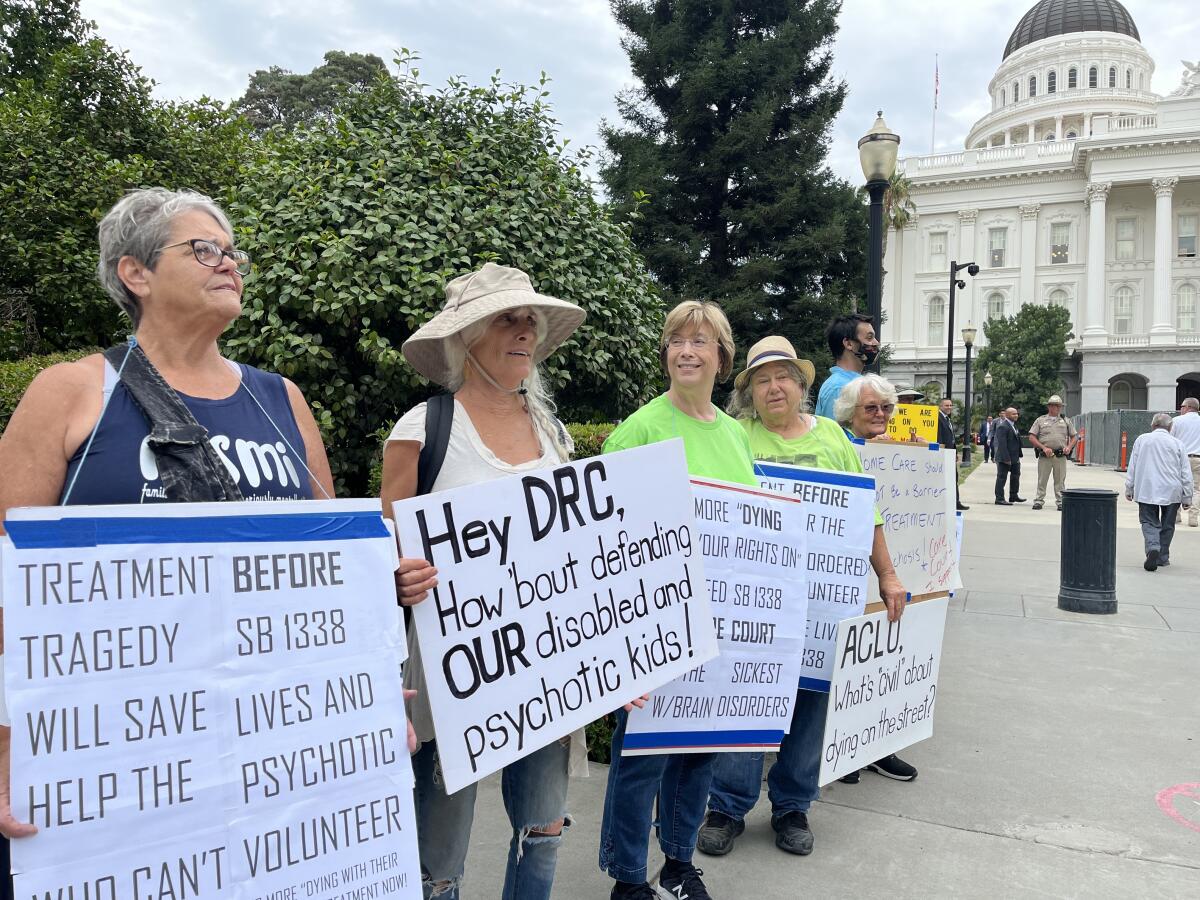‘Deep in the weeds’: California counties face unknowns in launching mental illness court

- Share via
In four months, the gavel will fall, and the state’s first CARE Courts will be in session.
Seven counties opted for an Oct. 1 rollout of the law that orders each county to create special courts, whose judges have the authority to order treatment plans for individuals with untreated schizophrenia and related disorders. Even though the plans are not compulsory, the courts hope for compliance as the law tries to straddle a line between voluntary and mandated treatment.
The CARE Act, signed into law by Gov. Gavin Newsom last September, requires counties to come up with the bureaucratic mechanisms that will support the goal of easing an epidemic of severe mental illness on the streets and in communities.
“We’re deep in the weeds, thinking about what will be the daily lives of the people who engage in this work,” said Luke Bergmann, the behavioral health director for San Diego County.
Among the many challenges of the CARE Act is developing a manageable workflow for disparate groups.
For every individual appearing in the court, there will be the clerks who processed the petitions that initiated the proceedings, the outreach teams that found the individual and served the paperwork, the psychiatrists who prepared a treatment plan, defense attorneys who will represent the individual, behavioral health clinicians who will present the plan and the judges who will negotiate its implementation.
In addition, there will be insurance companies that pay for the plan, administrators who manage the paperwork associated with the plan and healthcare providers who execute the plan.
In L.A. County, CARE Court will be implemented next year. Here’s how you can access it.
The first group — San Diego, Orange, Riverside, San Francisco, Stanislaus, Tuolumne and Glenn — reflects the geographic and demographic diversity of California. Their courts will serve as a template for Los Angeles and the 50 other counties. (L.A. County will open its court on Dec. 1; the rest of the state has until Oct. 1, 2024.)
Many counties will be playing catch-up with a crisis that has gone unchecked for decades. County supervisors and behavioral health directors describe a neglected system with an unknown number of people who may be eligible for a CARE Court.
The state has estimated that 7,000 to 12,000 people will qualify for a treatment plan. The range is so broad, officials say, in part because the law allows roommates or family members to initiate an assessment of a family member suspected of having a severe mental illness.
Some counties are concerned that they will be overwhelmed by families who have been unable to seek assistance caring for individuals with mental illness by laws that protect their rights and privacy.
They are braced as well for the frustration from families whose requests are denied for not meeting the criteria specified by the law. Those brought into a CARE Court must be 18 or older, diagnosed with “schizophrenia spectrum and other psychotic disorders” and not currently being treated.
“We’re just not sure who this law will bring to the door,” said Veronica Kelley, Orange County’s behavioral health director.
Orange County estimates it will receive petitions for about 1,500 people the first year, with about 1,000 of them meeting the court’s criteria. Of those, officials estimate, nearly 300 are expected to agree to a treatment plan without having to be brought into CARE Court, leaving 700 for the court to monitor for at least a year.

One of the smaller counties, Stanislaus, has identified 150 people who will qualify based on frequent emergency room visits. “Beyond that,” said county Supervisor Terry Withrow, “it’s anyone’s guess.”
Such estimates are critical for counties needing to hire staff at a time when the state is experiencing a shortage of behavioral health workers. Meeting that need will be harder on rural counties, which have fewer providers capable of working with people suffering from acute mental illness.
“In a small county, it’s not like staffing will grow to meet capacity, especially when it comes to administration and management,” said Joe Hallett, behavioral health director for Glenn County, 60 miles north of Sacramento. “Instead, we just add these new responsibilities to the existing workload.”
Health directors like Hallett are looking to lawmakers in Sacramento for continued advocacy and support. Glenn County will receive nearly $1.4 million in early allocations.
Startup funding for the CARE Act was $57 million. The state budgeted $26 million to be divided among the first group of counties as they work out whatever kinks arise in implementation. Another distribution of $31 million will be shared among all counties in advance of full implementation in 2024.
While Orange County received one of the highest allocations — $7.1 million — Kelley is concerned about lawmakers’ resolve keeping the CARE Act fully funded.
“That’s good for one year,” she said, “but for the ensuing year, we don’t know.”
Funding behavioral health services was one reason Riverside County signed up early, said Jeff Van Wagenen, the county’s chief executive officer, who argues that it has not received support from the state commensurate with its population growth. The first allocation of $6.6 million will help, but what comes after the first year is unknown.
“One of the concerns of CARE Court is that it could be the latest unfunded mandate from the state,” he said.
Reflected in Sacramento’s budget for CARE Court is the presumption that the initial counties will work out kinks in the legislation so that other counties can start up their courts at less expense. This means answering a number of mundane yet critical questions left unaddressed by the law itself.
For instance, who should serve the petition and transport individuals to the court?
While behavioral health departments may seem the logical choice, Bergmann is concerned that it creates a conflict of interest when the agency bringing the person to court represents the interests of the party who petitioned the court. Enlisting law enforcement for this task is equally problematic for encounters on the street that will likely require more trust than authority, he said.
Building that trust is one reason why Orange County is making provisions for its staff to help family members fill out the petitions that the court needs to initiate the intervention.
“We imagine a loved one at wit’s end — agitated, frustrated and tired — for all they have been through getting to this moment,” Kelley said. “So, the court staff has to be ready for that. We’re also trying to get the $433 filing fee waived. That’s a lot of money.”
The CARE Act — like other attempts to legislate treatment for severe mental illness in California — is constrained by the Lanterman-Petris-Short Act.
To help families understand the process, Riverside County is developing an app that will chart individual progress through the CARE system. The county also might conduct remote civil hearings, so that someone living in Blythe, for instance, would not have to go to court in Riverside, 170 miles away.
“All we need is a table, chair and laptop,” Van Wagenen said. “So we could buy a van and convert it into a mobile courtroom. This would avoid the problem of having to store property or board pets for those who are experiencing homelessness.”
Homeless people create a unique dilemma for counties required to hold a case management hearing within two weeks of determining the validity of the applicant’s petition.
“We will need more than 14 days to find the person and to try to get them to agree to treatment,” Kelley said. “What if a person has moved to a different county? We can’t extend all our resources, trying to find them. We’re not investigators.”

Hallett, with Glenn County, has similar concerns. The two-week window is “really, really fast to find someone, do outreach and process a report,” he said. “A month would be more reasonable.”
Yet lawmakers wrote the law with the intention of pressuring counties to act quickly, leaving counties to meet that timeline or pay a price.
“The CARE plan is like a settlement agreement between the county and the respondent,” said Jacqueline Wong-Hernandez, chief policy officer for the California State Assn. of Counties. “Once a plan is in place, the petitioner falls away, and an agreement to comply has to be struck between the county behavioral health department and participants in the court.”
The stakes for not meeting the 14-day deadline are high. If the court finds the county to be noncompliant, a $1,000-a-day sanction per case can be levied.
Dr. Mark Ghaly, secretary of the California Health and Human Services Agency, calls the counties’ efforts so far “very promising.”
Not only does the legislation hope to change “the arc of lives of some of the most vulnerable among us,” but it also represents “a culture shift in how we collectively as a system do business, which will take time and repetition.“
“Frankly,” he said, “it is our responsibility to do better.“
As much as behavioral health directors welcome the CARE Act, they emphasize that additional work is required to address broader and deeper problems in the state’s behavioral health system.
“We’re moving too quickly,” Kelley said. “Give us five years, which is how long the county needs in order to build anything. Without the infrastructure, these programs won’t be as successful as the Legislature wants, and we might lose people whom we could be serving in the process.”
Newsom hopes to address this deficiency by creating new revenue streams for housing and services, but his proposals are contingent on voters and will take years to put in place.
“We’re standing at the front door,” Bergmann said. “We’re painting it, we’re putting in windows, we’re outlining it with mother of pearl, and yet when we walk in, we find a building without a roof.”
More to Read
Sign up for Essential California
The most important California stories and recommendations in your inbox every morning.
You may occasionally receive promotional content from the Los Angeles Times.













